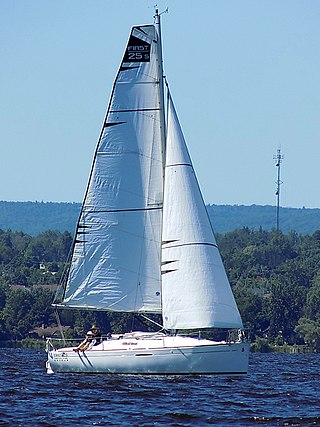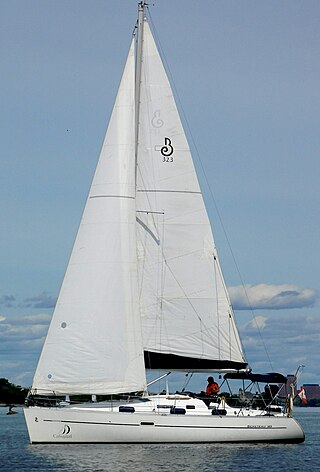Related Research Articles
The El Toro is an American pram sailboat that was designed by Charles McGregor as a sail training dinghy and yacht tender, first built in 1939. It is now often sailed as a singlehanded one-design racer.

The Fireball is a British sailing dinghy that was designed by Peter Milne as a one-design racer and first built in 1962.

The Farr 30, originally called the Mumm 30, is a sailboat that was designed by Bruce Farr as a one design racer and first built in 1995.

The Hobie Tiger or Hobie Tiger 18, is a French catamaran sailboat that was designed by Hobie Cat Europe as a Formula 18 racer and first built in 1995.

The Redline 25, sometimes called the C&C 25 Redline, is a Canadian sailboat, that was designed by C&C Design and first built in 1969.

The Beneteau First 25S is a French sailboat, that was designed by Group Finot/Conq and first built in 2008.
The Beneteau First 25.7 is a French sailboat, that was designed by Group Finot and first built in 2004.
The Beneteau First 260 Spirit is a French sailboat, that was designed by Group Finot and first built in 1994.

The Beneteau 323 is a French sailboat that was designed by Jean Marie Finot and Pascal Conq of Group Finot/Conq and first built in 2001.

The Beneteau Figaro 2 or Beneteau Figaro II, officially designated as the Figaro Beneteau II, is a French sailboat that was designed by Marc Lombard as a one design, single-handed, off-shore racer for the Solitaire du Figaro race and first built in 2003. The boat and the race are named for the race's sponsor, the French newspaper Le Figaro.

The Beneteau Figaro 3, officially called the Figaro Beneteau 3, is a French hydrofoil-equipped sailboat that was designed by Van Peteghem/Lauriot-Prevost as a one design racer specifically for the Solitaire du Figaro race and first built in 2018. The boat and the race are named for the race's sponsor, the French newspaper Le Figaro.

The RS Quest is a British sailboat that was designed by Jo Richards as a sail trainer and day sailer. It was first built in 2015.

The Melges 15 is an American sailboat that was designed by Reichel/Pugh as a two-crew, one-design racer and sail trainer. First built in 2020, it is Reichel/Pugh's design #289.
The Melges 14 is an American planing sailboat that was designed by Reichel/Pugh as a one-design racer and first built in 2016.
The Beneteau 311, also called the Oceanis 311 and Oceanis 311 Clipper, is a French sailboat that was designed by Groupe Finot as a cruiser and first built in 1997 as a 1998 model year. The design was also sold as the Stardust 311 for the yacht charter market. The same hull design also served as the basis for the Figaro Solo, the Beneteau First 310, Beneteau First 31.7 and the Beneteau Oceanis 300.

The Beneteau First 305 is a French sailboat that was designed by Jean Berret as a cruiser-racer and first built in 1984.

The Nacra F16 is a Dutch catamaran sailing dinghy that was designed by Americans Morrelli and Melvin as a one-design Formula 16 racer and first built in 2011.
The First 18 is a French trailerable sailboat that was designed by Groupe Finot as a Micro Class racer-cruiser and day sailer and first built in 1978.
The Beneteau First 18 SE, previously called the Beneteau First 18 and the Seascape 18, is a French trailerable sailboat that was designed by Samuel Manuard as a planing one design racer-cruiser and first built in 2008. The industrial design work was done by Gigodesign.
The Beneteau First 20 is a French trailerable sailboat that was designed by Finot/Conq as a cruiser-racer and first built in 2011.
References
- 1 2 3 4 5 6 McArthur, Bruce (2023). "First 14 (Beneteau)". sailboatdata.com. Archived from the original on 7 September 2023. Retrieved 7 September 2023.
- 1 2 McArthur, Bruce (2023). "First 14 SE (Beneteau)". sailboatdata.com. Archived from the original on 7 September 2023. Retrieved 7 September 2023.
- 1 2 3 4 5 6 Sea Time Tech, LLC (2023). "First 14 (Beneteau)". sailboat.guide. Archived from the original on 7 September 2023. Retrieved 7 September 2023.
- 1 2 3 4 5 6 7 "First 14 Sailboat specifications". Boat-Specs.com. 2023. Archived from the original on 7 September 2023. Retrieved 7 September 2023.
- 1 2 3 4 5 6 7 "Seascape 14 Sailboat specifications". Boat-Specs.com. 2023. Archived from the original on 7 September 2023. Retrieved 7 September 2023.
- 1 2 3 4 5 Beneteau. "First 14". beneteau.com. Archived from the original on 7 September 2023. Retrieved 7 September 2023.
- 1 2 Beneteau. "First 14" (PDF). beneteau.com. Archived (PDF) from the original on 30 January 2023. Retrieved 7 September 2023.
- ↑ Beneteau. "First 14 Standard Configuration & Options Specifications" (PDF). beneteau.com. Archived (PDF) from the original on 7 September 2023. Retrieved 7 September 2023.
- 1 2 3 Beneteau. "First 14SE". beneteau.com. Archived from the original on 7 September 2023. Retrieved 7 September 2023.
- 1 2 Beneteau. "First 14 SE" (PDF). beneteau.com. Archived (PDF) from the original on 30 January 2023. Retrieved 7 September 2023.
- ↑ McArthur, Bruce (2023). "Samuel Manuard". sailboatdata.com. Archived from the original on 7 September 2023. Retrieved 7 September 2023.
- ↑ "Sam Manuard Yacht Design Sailboat designer". Boat-Specs.com. 2023. Archived from the original on 3 March 2023. Retrieved 7 September 2023.
- ↑ McArthur, Bruce (2023). "Beneteau". sailboatdata.com. Archived from the original on 30 September 2020. Retrieved 7 September 2023.
- ↑ Sea Time Tech, LLC (2023). "Beneteau". sailboat.guide. Archived from the original on 1 May 2023. Retrieved 7 September 2023.
- ↑ "Bénéteau Sailboat builder". Boat-Specs.com. 2023. Archived from the original on 22 June 2023. Retrieved 7 September 2023.
- ↑ McArthur, Bruce (2023). "Seascape (Slov)". sailboatdata.com. Archived from the original on 7 September 2023. Retrieved 7 September 2023.
- ↑ Sea Time Tech, LLC (2023). "Seascape". sailboat.guide. Archived from the original on 7 September 2023. Retrieved 7 September 2023.
- ↑ "Seascape Sailboat builder". Boat-Specs.com. 2023. Archived from the original on 7 September 2023. Retrieved 7 September 2023.
- 1 2 3 "Best Boats 2019". Sail Magazine. 14 November 2018. Archived from the original on 23 May 2023. Retrieved 7 September 2023.
- 1 2 Beneteau (16 January 2021). "First and First SE: Beneteau introduces new members of seventh generation of First". sail-world.com. Archived from the original on 7 September 2023. Retrieved 7 September 2023.
- ↑ "2019 Beneteau First 14". Yacht Hub. Archived from the original on 7 September 2023. Retrieved 7 September 2023.